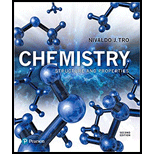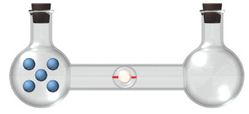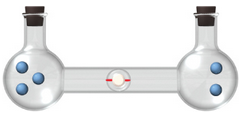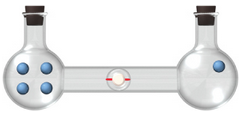
Solutions Manual For Chemistry: Structure And Properties
2nd Edition
ISBN: 9780134460697
Author: Tro
Publisher: PEARSON
expand_more
expand_more
format_list_bulleted
Textbook Question
Chapter 18, Problem 104E
Calculate the entropy of each state and rank the states in order of increasing entropy.
Expert Solution & Answer
Want to see the full answer?
Check out a sample textbook solution
Students have asked these similar questions
Please predict the products for each of the
following reactions.
Clearly show the regiochemistry (Markovnikov
vs anti-Markovnikov) and stereochemistry
(syn- vs anti- or both).
If a mixture of enantiomers is formed, please
draw all the enantiomers.
cold
KMnO4, NaOH
2. DMS
1. 03
CH3OH
Br2
1.
03
2. (CH3)2S
H₂
Pd or Pt (catalyst)
HBr
18
19
20 1
HBr
ROOR (peroxide)
H₂O
H₂SO4
HCI
HI
17
16
6
15
MCPBA
1. BH3 THF
2. H₂O2, NaOH
1. OsO4
2. H₂O₂
110
CH3CO₂H
(peroxyacid)
1. MCPBA
2. H₂O*
Br2
H₂O
BH3 THF
B12
EtOH
Pd or Ni (catalyst)
D₂ (deuterium)
Bra
A
B
C
D
H
OH
H
OH
OH
H
OH
α α α
OH
H
OH
OH
фон
d
H
"H
Briefly indicate the models that describe the structure of the interface: Helmholtz-Perrin, Gouy-Chapman, Stern and Grahame models.
Electrochemistry. Briefly describe the Gibbs model and the Gibbs absorption equation.
Chapter 18 Solutions
Solutions Manual For Chemistry: Structure And Properties
Ch. 18 - What is the first law of thermodynamics, and how...Ch. 18 - What is nature’s heat tax, and how does it relate...Ch. 18 - What is a perpetual motion machine? Can such a...Ch. 18 - Is it more efficient to heat your home with a...Ch. 18 - What is a spontaneous process? Provide an example.Ch. 18 - Explain the difference between the spontaneity of...Ch. 18 - What is the precise definition of entropy? What is...Ch. 18 - Why does the entropy of a gas increase when it...Ch. 18 - Explain the difference between macrostates and...Ch. 18 - Based on its fundamental definition, explain why...
Ch. 18 - State the second law of thermodynamics. How does...Ch. 18 - What happens to the entropy of a sample of matter...Ch. 18 - Explain why water spontaneously freezes to form...Ch. 18 - Why do exothermic processes tend to be spontaneous...Ch. 18 - What is the significance of the change in Gibbs...Ch. 18 - Predict the spontaneity of a reaction (and the...Ch. 18 - State the third law of thermodynamics and explain...Ch. 18 - Why is the standard entropy of a substance in the...Ch. 18 - How does the standard entropy of a substance...Ch. 18 - How can you calculate the standard entropy change...Ch. 18 - Describe the three different methods to calculate...Ch. 18 - Why is free energy “free”?Ch. 18 - Explain the difference between G and G .Ch. 18 - Why does water spilled on the floor evaporate even...Ch. 18 - How do you calculate the change ¡n free energy for...Ch. 18 - How does the value of G for a reaction relate to...Ch. 18 - Prob. 27ECh. 18 - Prob. 28ECh. 18 - Prob. 29ECh. 18 - Prob. 30ECh. 18 - Calculate the change in entropy that occurs in the...Ch. 18 - Prob. 32ECh. 18 - Calculate the change ¡n entropy that occurs in the...Ch. 18 - Prob. 34ECh. 18 - Without doing any calculations, determine the sign...Ch. 18 - Prob. 36ECh. 18 - Without doing any calculations, determine the sign...Ch. 18 - Prob. 38ECh. 18 - Calculate Ssurr at the indicated temperature for...Ch. 18 - Prob. 40ECh. 18 - Given the values of Hrxn , Srxn and T, determine...Ch. 18 - Prob. 42ECh. 18 - Prob. 43ECh. 18 - Prob. 44ECh. 18 - Calculate the free energy change for the reaction...Ch. 18 - Prob. 46ECh. 18 - Prob. 47ECh. 18 - Predict the conditions (high temperature, low...Ch. 18 - How does the molar entropy of a substance change...Ch. 18 - What is the molar entropy of a pure crystal at 0...Ch. 18 - For each pair of substances, choose the one that...Ch. 18 - For each pair of substances, choose the one that...Ch. 18 - Rank each set of substances in order of increasing...Ch. 18 - Prob. 54ECh. 18 - Use data from Appendix IIB to calculate Srxn for...Ch. 18 - Use data from Appendix IIB to calculate Srxn for...Ch. 18 - Find S for the formation of CH2Cl2(g) from its...Ch. 18 - Prob. 58ECh. 18 - Methanol burns in oxygen to form carbon dioxide...Ch. 18 - In photosynthesis, plants form glucose (C6H12O6)...Ch. 18 - For each reaction, calculate Hrxn , Srxn and Grxn...Ch. 18 - For each reaction calculate Hrxn , Srxn and Grxn...Ch. 18 - Use standard free energies of formation to...Ch. 18 - Use standard free energies of formation to...Ch. 18 - Consider the reaction: 2NO(g)+O2(g)2NO2(g)...Ch. 18 - Prob. 66ECh. 18 - Determine G for the reaction:...Ch. 18 - Prob. 68ECh. 18 - Consider the sublimation of iodine at 25.0°C:...Ch. 18 - Consider the evaporation of methanol at 25.0°C....Ch. 18 - Consider the reaction: CH3OH(g)CO(g)+2H2(g)...Ch. 18 - Consider the reaction: CO2(g)+CCl4(g)2COCl2(g)...Ch. 18 - Use data from Appendix IIB to calculate the...Ch. 18 - Prob. 74ECh. 18 - Prob. 75ECh. 18 - Prob. 76ECh. 18 - Prob. 77ECh. 18 - Prob. 78ECh. 18 - Consider the reaction: H2(g)+I2(g)2HI(g) The...Ch. 18 - Consider the reaction: 2N0(g) — O(g) 2N02(g) The...Ch. 18 - The change in enthalpy (Hrxn) for a reaction is...Ch. 18 - Prob. 82ECh. 18 - Prob. 83ECh. 18 - Prob. 84ECh. 18 - Our atmosphere is composed primarily of nitrogen...Ch. 18 - Prob. 86ECh. 18 - Ethene (C2H4) can be halogenated by the reaction:...Ch. 18 - H2 reacts with the halogens (X2) according to the...Ch. 18 - Consider this reaction occurring at 298 K:...Ch. 18 - Consider this reaction occurring at 298 K:...Ch. 18 - Prob. 91ECh. 18 - Prob. 92ECh. 18 - These reactions are important in catalytic...Ch. 18 - Prob. 94ECh. 18 - All the oxides of nitrogen have positive values of...Ch. 18 - Prob. 96ECh. 18 - Consider the reaction X2(g)2X(g) . When a vessel...Ch. 18 - Prob. 98ECh. 18 - Indicate and explain the sign of Suniv for each...Ch. 18 - The Haber process is very important for...Ch. 18 - A metal salt with the formula MCl2 crystallizes...Ch. 18 - The solubility of AgCI(s) in water at 25°C is...Ch. 18 - Review the subsection in this chapter entitled...Ch. 18 - Calculate the entropy of each state and rank the...Ch. 18 - Suppose we redefine the standard state as P=2atm ....Ch. 18 - The G for the freezing of H2O(l) at 10°C is 210...Ch. 18 - Consider the reaction that occurs during the Haber...Ch. 18 - The salt ammonium nitrate can follow three modes...Ch. 18 - Given the tabulated data, calculate Svap for each...Ch. 18 - Prob. 110ECh. 18 - Prob. 111ECh. 18 - Consider the changes in the distribution of nine...Ch. 18 - Prob. 113ECh. 18 - Prob. 114ECh. 18 - Prob. 115ECh. 18 - The reaction A(g)B(g) has an equilibrium constant...Ch. 18 - Prob. 117ECh. 18 - Prob. 118ECh. 18 - Prob. 119ECh. 18 - Have each group member look up Hf and S for one...Ch. 18 - Calculate G at 25°C for the reaction in the...Ch. 18 - Prob. 122ECh. 18 - Which reaction Is most likely to have a positive...Ch. 18 - Prob. 2SAQCh. 18 - Arrange the gases—F2, Ar, and CH3F—in order of...Ch. 18 - Prob. 4SAQCh. 18 - Prob. 5SAQCh. 18 - For a certain reaction Hrxn=255kJ and Srxn=211J/K...Ch. 18 - Prob. 7SAQCh. 18 - s8. Use standard free energies of formation to...Ch. 18 - Prob. 9SAQCh. 18 - For the following reaction, Grxn=9.4kJ at 25 °C....Ch. 18 - Prob. 11SAQCh. 18 - Prob. 12SAQCh. 18 - Prob. 13SAQCh. 18 - Prob. 14SAQCh. 18 - Prob. 15SAQCh. 18 - Prob. 16SAQ
Additional Science Textbook Solutions
Find more solutions based on key concepts
An aluminum calorimeter with a mass of 100 g contains 250 g of water. The calorimeter and water are in thermal ...
Physics for Scientists and Engineers
1. Rub your hands together vigorously. What happens? Discuss the energy transfers and transformations that take...
College Physics: A Strategic Approach (3rd Edition)
How could you separate a mixture of the following compounds? The reagents available to you are water, either, 1...
Organic Chemistry (8th Edition)
Single penny tossed 20 times and counting heads and tails: Probability (prediction): _______/20 heads ________/...
Laboratory Manual For Human Anatomy & Physiology
Label each statement about the polynucleotide ATGGCG as true or false. The polynucleotide has six nucleotides. ...
General, Organic, and Biological Chemistry - 4th edition
Knowledge Booster
Learn more about
Need a deep-dive on the concept behind this application? Look no further. Learn more about this topic, chemistry and related others by exploring similar questions and additional content below.Similar questions
- Briefly state the electrocapillary equation for ideally polarized electrodes.arrow_forwardWhat is surface excess according to the Gibbs model?arrow_forwardUsing Benzene as starting materid show how each of the Following molecules Contel Ve syntheswed CHI 9. b -50311 с CHY 503H Ночто d. อ •NOV e 11-0-650 NO2arrow_forward
- The molecule PYRIDINE, 6th electrons and is therefore aromatre and is Assigned the Following structure contering Since aromatk moleculoy undergo electrophilic anomatic substitution, Pyridine shodd undergo The Following reaction + HNO3 12504 a. write all of the possible Mononitration Products that could Result From this reaction 18. Bared upon the reaction mechanison determime which of these producty would be the major Product of the hegetionarrow_forwarda. Explain Why electron withdrawing groups tend to be meta-Directors. Your answer Should lyclude all apropriate. Resonance contributing Structures fo. Explain why -ll is an outho -tura drccton even though chlorine has a very High Electronegativityarrow_forward9. Write Me product as well as the reaction Mechanism For each of the Following Vanctions +H₂504 4.50+ T C. +212 Fellz 237 b. Praw the potential energy Diagrams For each OF Mese Rauctions and account For any differences that appear in the two potential Puergy Diagrams which of here two reactions 19 Found to be Reversable, Rationalice your answer based upon the venation mechanisms and the potential energy diagrams.arrow_forward
- 9. Write Me product as well as the reaction Mechanism For each of the Following Veritious +H2504 4.50+ + 1/₂ Felly ◎+ 7 b. Praw he potential energy Diagrams For each OF Mese Ronctions and account for any differences that appeak in the two potential Puergy Diagramsarrow_forwardDraw the major product of this reaction. Ignore inorganic byproducts. Incorrect, 3 attempts remaining 1. excess Br2, NaOH 2. neutralizing workup Qarrow_forwardGiven the electrode Pt | Ag | Ag+ (aq), describe it.arrow_forward
arrow_back_ios
SEE MORE QUESTIONS
arrow_forward_ios
Recommended textbooks for you
- Chemistry: Matter and ChangeChemistryISBN:9780078746376Author:Dinah Zike, Laurel Dingrando, Nicholas Hainen, Cheryl WistromPublisher:Glencoe/McGraw-Hill School Pub Co
 Chemistry: The Molecular ScienceChemistryISBN:9781285199047Author:John W. Moore, Conrad L. StanitskiPublisher:Cengage Learning
Chemistry: The Molecular ScienceChemistryISBN:9781285199047Author:John W. Moore, Conrad L. StanitskiPublisher:Cengage Learning
 Introductory Chemistry: A FoundationChemistryISBN:9781337399425Author:Steven S. Zumdahl, Donald J. DeCostePublisher:Cengage Learning
Introductory Chemistry: A FoundationChemistryISBN:9781337399425Author:Steven S. Zumdahl, Donald J. DeCostePublisher:Cengage Learning Principles of Modern ChemistryChemistryISBN:9781305079113Author:David W. Oxtoby, H. Pat Gillis, Laurie J. ButlerPublisher:Cengage Learning
Principles of Modern ChemistryChemistryISBN:9781305079113Author:David W. Oxtoby, H. Pat Gillis, Laurie J. ButlerPublisher:Cengage Learning Chemistry & Chemical ReactivityChemistryISBN:9781133949640Author:John C. Kotz, Paul M. Treichel, John Townsend, David TreichelPublisher:Cengage Learning
Chemistry & Chemical ReactivityChemistryISBN:9781133949640Author:John C. Kotz, Paul M. Treichel, John Townsend, David TreichelPublisher:Cengage Learning

Chemistry: Matter and Change
Chemistry
ISBN:9780078746376
Author:Dinah Zike, Laurel Dingrando, Nicholas Hainen, Cheryl Wistrom
Publisher:Glencoe/McGraw-Hill School Pub Co

Chemistry: The Molecular Science
Chemistry
ISBN:9781285199047
Author:John W. Moore, Conrad L. Stanitski
Publisher:Cengage Learning


Introductory Chemistry: A Foundation
Chemistry
ISBN:9781337399425
Author:Steven S. Zumdahl, Donald J. DeCoste
Publisher:Cengage Learning

Principles of Modern Chemistry
Chemistry
ISBN:9781305079113
Author:David W. Oxtoby, H. Pat Gillis, Laurie J. Butler
Publisher:Cengage Learning

Chemistry & Chemical Reactivity
Chemistry
ISBN:9781133949640
Author:John C. Kotz, Paul M. Treichel, John Townsend, David Treichel
Publisher:Cengage Learning
The Laws of Thermodynamics, Entropy, and Gibbs Free Energy; Author: Professor Dave Explains;https://www.youtube.com/watch?v=8N1BxHgsoOw;License: Standard YouTube License, CC-BY


